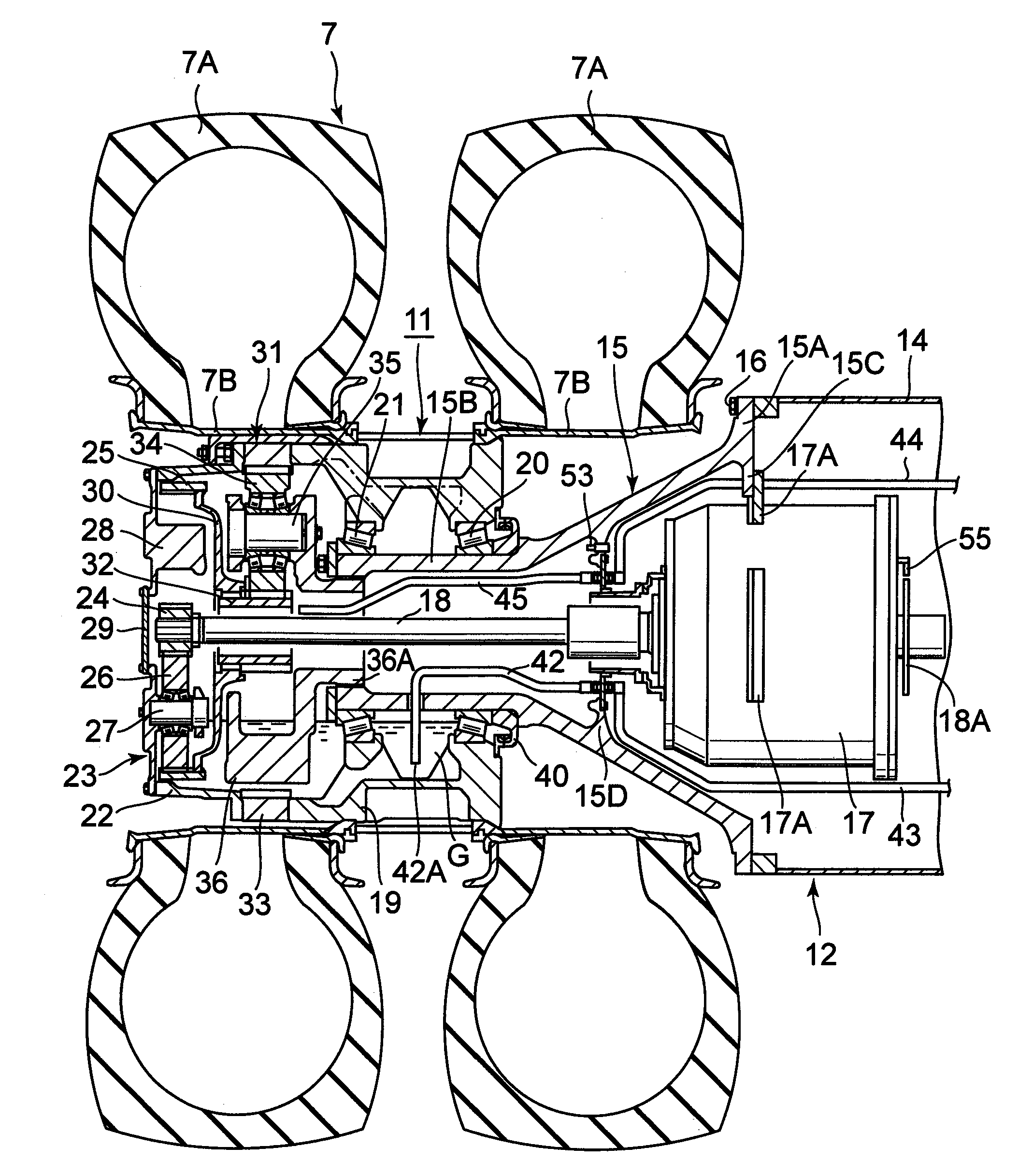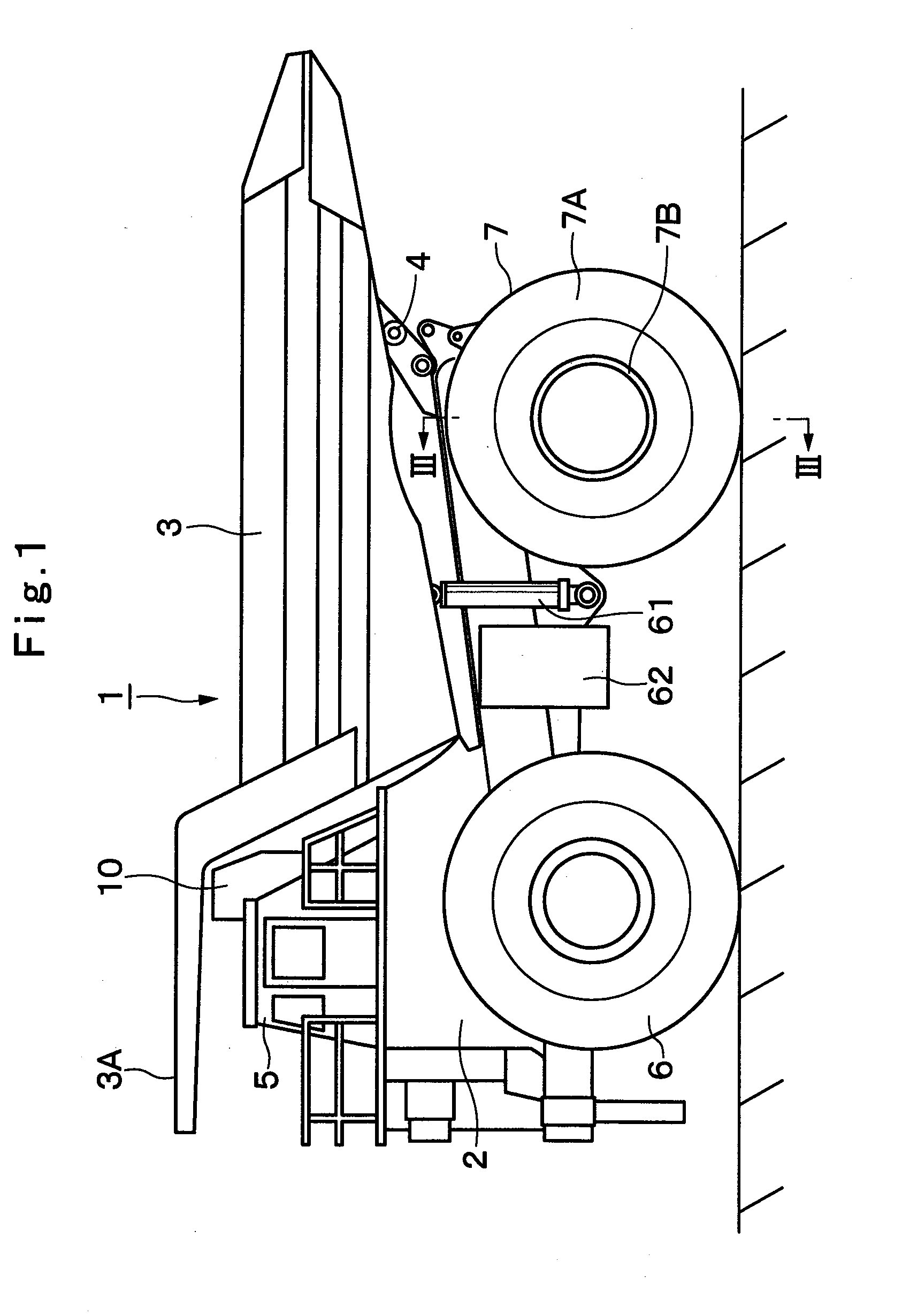Traveling drive unit for working vehicle
a technology for working vehicles and drive units, which is applied in the direction of axle units, toothed gearings, special data processing applications, etc., can solve the problems of shortening the service life of the pump itself, premature abrasive wear and damage to seals and bearings, and preventing dry idle operations more stably
- Summary
- Abstract
- Description
- Claims
- Application Information
AI Technical Summary
Benefits of technology
Problems solved by technology
Method used
Image
Examples
first embodiment
[0085]Shown in FIGS. 1 through 8 is the present invention, i.e., a traveling drive unit for a working vehicle.
[0086]In the drawings, indicated at 1 is a dump truck adopted in the first embodiment as a typical working vehicle. As shown in FIG. 1, the dump truck 1 is built with a sturdy frame structure, and largely constituted by an automotive vehicle body 2 with front and rear wheels 6 and 7, and a vessel 3 which is liftably mounted on the vehicle body 2 as a load-carrying platform.
[0087]Further, the vessel 3 is formed as a large-size container whose overall length reaches as much as 10 to 13 meters to load a large volume of heavy load such as crushed stones or other similar objects, and its rear side bottom portion is liftably (tiltably) coupled to a rear end side of the vehicle body 2 by using a pin coupling portion 4 and the like. Further, protector 3A is projected forward from a front top of the vessel 3 in such a way as to cover a cabin 5 from upper side, which will be described...
second embodiment
[0170]This second embodiment has a feature in that the operation of the lubricant circulation pump 46 is turned on and off by way of an on-off control of the pump drive motor 47 in relation with the temperature T of lubricant oil G, vehicle speed V and output pressure P of the lubricant circulation pump 46.
[0171]Namely, in a lubricant oil supply control routine of FIG. 9, Steps 21 to 29 are executed to carry out the same processing as in Steps 1 to 9 in the first embodiment (FIG. 8). In next Step 30, an output pressure P of the lubricant circulation pump 46 is read in from a pressure sensor 52 (see FIGS. 4 and 7) to judge whether or not the output pressure P is higher than a predetermined reference pressure P1 in Step 31.
[0172]In this instance, the reference pressure P1 is a criterial value to be used in making a judgment as to whether or not the lubricant circulation pump 46 is put in a dry idling operation, that is, disabled to suck in lubricant oil G due to decrease of lubricant ...
third embodiment
[0181]In short, the third embodiment has features in that, by the use of an indicator 57 of FIG. 7, for example, a warning information is given to an operator in the cabin 5 when the temperature T of lubricant oil G has risen for example, in excess of a warning temperature T2 of 90° C. to 100° C. (T2>T1), warning the operator that the temperature T of lubricant oil G is at a high level.
[0182]In this instance, the warning temperature T2 means a temperature value (e.g., 90° C. to 100° C.) which is far higher than the afore-mentioned reference temperature T1 (e.g., 40° C. to 60° C.) in the first embodiment, i.e., for judging an abnormality in the lubricant oil circulation device 41.
[0183]Namely, in the case of the lubricant oil supply control routine of FIG. 10, Steps 41 and 42 are executed to carry out the same processing as in Steps 1 and 2 of the control routine in the first embodiment (see FIG. 8). Then, in next Step 43, a judgment is made as to whether or not the temperature T of ...
PUM
 Login to View More
Login to View More Abstract
Description
Claims
Application Information
 Login to View More
Login to View More - R&D
- Intellectual Property
- Life Sciences
- Materials
- Tech Scout
- Unparalleled Data Quality
- Higher Quality Content
- 60% Fewer Hallucinations
Browse by: Latest US Patents, China's latest patents, Technical Efficacy Thesaurus, Application Domain, Technology Topic, Popular Technical Reports.
© 2025 PatSnap. All rights reserved.Legal|Privacy policy|Modern Slavery Act Transparency Statement|Sitemap|About US| Contact US: help@patsnap.com



